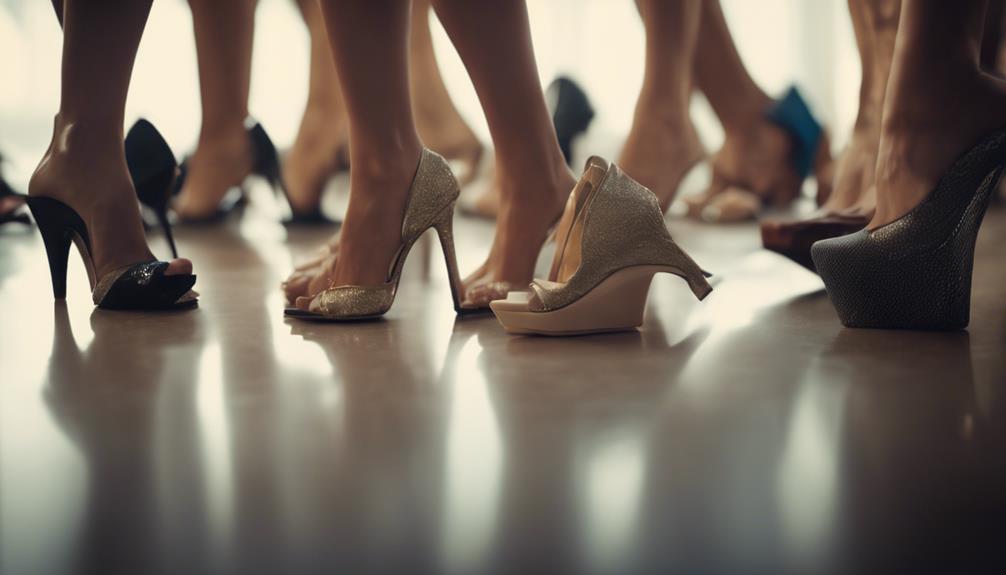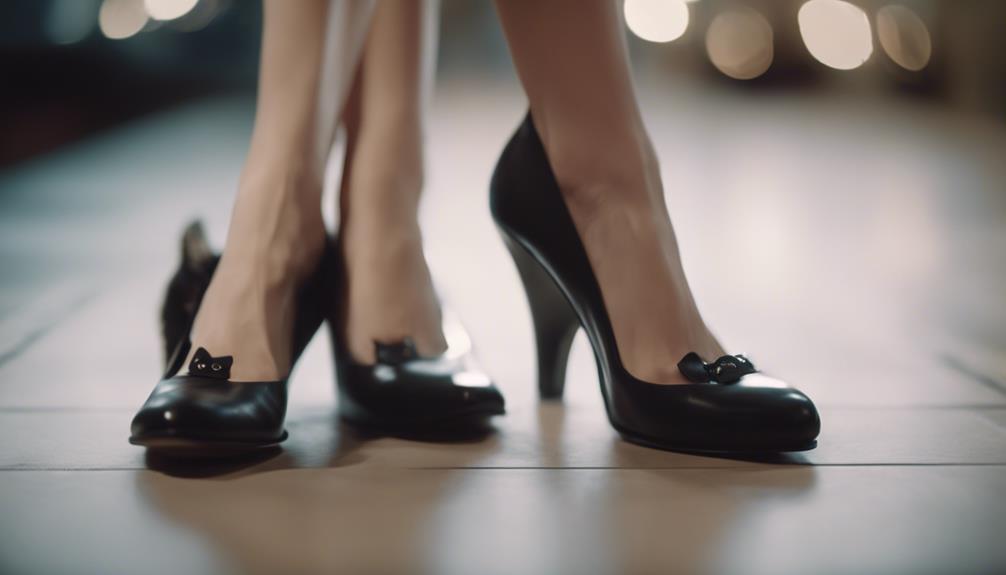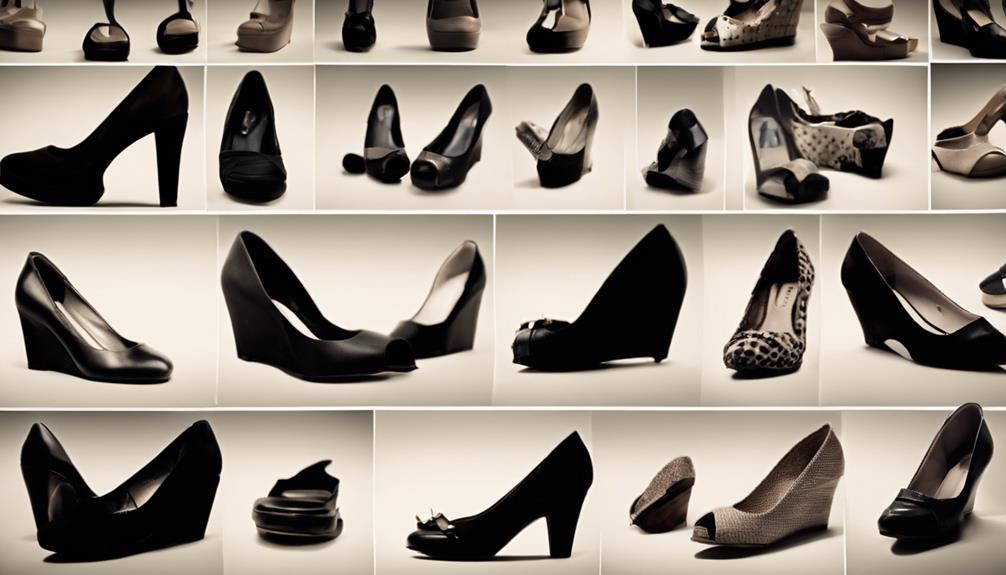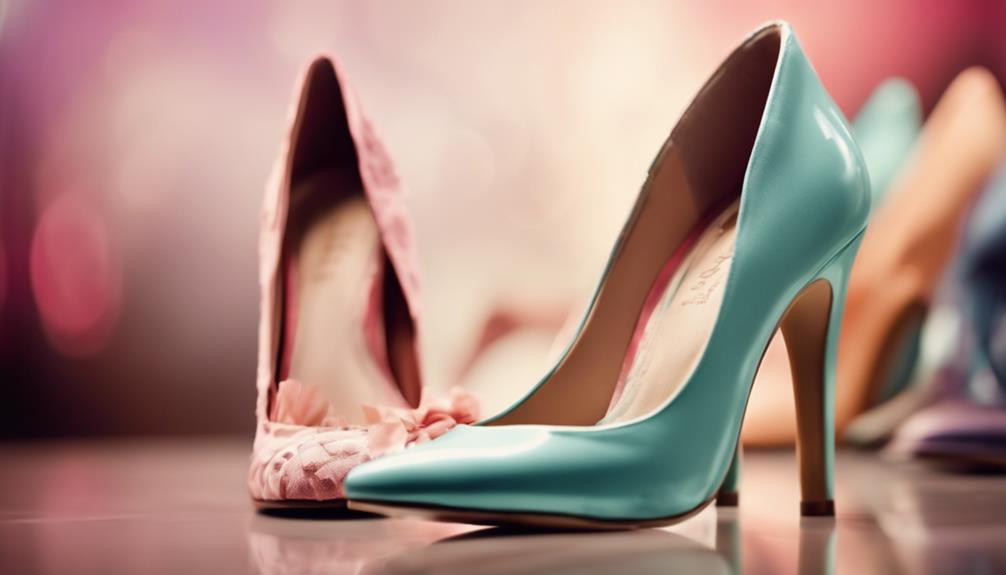I've finally figured out how to wear heels all day without my feet screaming for mercy. Understanding heel design is key; a gradual slope from foot to heel equals comfort. I've learned my foot size dictates the ideal heel height, making some heels more bearable than others. Choosing the right occasion for my heels, ensuring they have proper alignment, and always opting for soft insoles have been game changers. Ensuring a perfect fit and picking thicker heels for stability are my go-to strategies. And I've realized expensive doesn't always mean better. There's so much more to uncover on how to stay chic yet comfortable.
Key Takeaways
- Opt for platform heels for added height with even weight distribution and comfort.
- Choose heels with a center-aligned design to ensure stability and minimize discomfort.
- Select thicker heels to enhance stability and support, distributing body weight more evenly.
- Prioritize heels with soft, cushioned insoles made from materials like memory foam or gel for shock absorption.
- Ensure proper fit by trying on heels and walking around before purchase to avoid pain and discomfort from ill-fitting shoes.
Understanding Heel Slope

The heel incline, an important factor in shoe comfort, directly influences how comfortably we can wear high heels. It's all about the angle between our foot and the heel, which greatly affects our experience. A longer distance from foot to heel crafts a more gradual slope, enhancing comfort by creating a less sudden change for our foot. Conversely, a shorter distance results in a steeper slope, often leading to discomfort and even pain after prolonged wear.
For those of us seeking innovation in our footwear, understanding this principle is vital. The comfort level of high heels isn't just about the heel height; it's also about how the shoe's design accommodates the natural arch of our foot. Ensuring the heel aligns well with our foot's arch, promoting even weight distribution, is key to minimizing discomfort.
As someone always on the lookout for the next breakthrough in fashion technology, I've learned that appreciating the subtleties of heel incline can dramatically change my experience with high heels. It's not just about how high the heel is, but how intelligently it's designed to fit and support the foot, ensuring comfort and style go hand in hand.
Identifying Your Ideal Height
Finding your perfect heel height requires measuring your foot's length in centimeters. It's a simple yet innovative approach to selecting footwear that guarantees I'm not just blindly following fashion trends but making choices that suit my body's unique needs. By dividing my foot's length by 7, I discover the recommended heel height that will likely offer me the most comfort. This formula reveals an intriguing fact: those of us with larger feet might actually find higher heels more comfortable, a concept that flips conventional wisdom on its head.
Understanding that my ideal heel height is as unique as my foot's size and shape empowers me to make smarter decisions when it comes to wearing high heels. It's not merely about the aesthetics but ensuring that the shoes I choose won't leave me in discomfort or pain after only a few hours of wear. By focusing on this tailored approach, I'm able to enjoy the elevation and elegance that heels bring to an outfit without the dreaded trade-off of discomfort that so often comes with it.
Choosing Heels for the Occasion

Selecting the right heels for any event involves considering both style and comfort, ensuring I'm prepared for long hours without sacrificing elegance. For special occasions, I lean towards stilettos for their sophisticated appearance, but I'm mindful of my body weight distribution to avoid discomfort. To counteract the potential stress on my feet, I opt for silicone insoles that offer extra support and cushioning. This little trick allows me to navigate through events with ease, minimizing the strain on my feet.
Clear insoles have become my go-to for their versatility. They seamlessly fit into any heel style, making them invisible while providing the necessary comfort. This innovation allows me to switch between different heels without worrying about the insoles clashing with the design.
When I'm aiming for added height without the discomfort, platform heels are my choice. They give me the elevation I desire while ensuring my body weight is evenly distributed, reducing the pressure on my feet. However, I'm cautious with overly thick platforms as they can distort my proportions and may not offer the comfort I'm after. By carefully selecting heels based on these considerations, I can enjoy any occasion with confidence and style.
Prioritizing Proper Alignment
When it comes to minimizing discomfort in heels, I've learned that proper alignment is non-negotiable.
By ensuring the heel's center aligns with my foot's arch, I can distribute my weight more evenly, which notably reduces pain.
This approach not only supports my foot's natural arch but also promotes a balanced posture, making a world of difference in comfort.
Importance of Posture
Prioritizing proper alignment in heel styles is essential for minimizing discomfort and enhancing overall posture. By ensuring that the heel is aligned with the foot's natural arch, we distribute weight evenly, greatly reducing strain. This correct posture and alignment not only prevent pain but also contribute to a more graceful and confident demeanor. Misalignment, on the other hand, can lead to instability and potential foot problems. It's a game-changer for those of us who cherish our heels but not the pain they often bring.
| Feature | Benefit | Impact on Posture |
|---|---|---|
| Center-aligned heels | Even weight distribution | Improved stability |
| Natural arch alignment | Enhanced comfort | Reduced foot strain |
| Proper heel positioning | Minimized discomfort | Better posture |
| Correct heel alignment | Prevention of pain | Confident walking |
Foot Arch Support
Building on the significance of posture, it's also essential to make sure the foot arch aligns with the heel arch to decrease heel discomfort. Misaligned arches are a recipe for pain, especially when I'm rocking my favorite heels for hours.
I've learned that aligning my foot arch with the heel arch isn't just about comfort; it's about preventing that dreaded foot pain that can ruin any good day or night out. Incorporating supportive insoles with arch support has been a game-changer for me.
It's about prioritizing foot arch support to make certain that every step I take is one closer to a pain-free experience in my heels. This little adjustment has made a massive difference in how I feel, proving it's all about the proper alignment.
Balanced Weight Distribution
To minimize discomfort in heels, it's crucial to make sure the shoes' alignment promotes balanced weight distribution across the foot. When the alignment's off, it's going to hurt, plain and simple. Misaligned heels shift weight unevenly, leading to pain and making every step a chore.
But, when you prioritize proper alignment, aligning the heels with the foot's natural arches, you're setting yourself up for a more comfortable experience. This isn't just about avoiding pain; it's about embracing innovation in how we wear our shoes. Centering heels under our body's arches helps prevent strain, ensuring we're not just looking good, but feeling good too.
Selecting Soft Insoles
When choosing soft insoles for heels, I've discovered they're essential for cushioning my feet, reducing both pain and discomfort immensely. It's a game-changer, really. The right insoles, made from materials like memory foam or gel, offer that extra layer of comfort that can make all the difference. They're not just about softness; they absorb shock and impact with every step I take, preventing that dreaded foot fatigue that used to cut my evenings short.
What's more, these soft insoles help distribute my weight evenly across my foot. This promotes better alignment and reduces strain, making it feel like I'm walking on air. It's as if my heels are now working with me, not against me. I've learned that selecting heels with these comfortable, soft insoles can greatly extend how long I can wear them without feeling like I'm sacrificing my feet's well-being for style.
This innovation in foot comfort has transformed my relationship with heels. No longer do I dread the thought of slipping into a stylish pair, fearing the inevitable discomfort. With soft insoles, I'm ready to stride forward with confidence and comfort.
Avoiding Common Mistakes

As we move on to talking about common mistakes, I've discovered that selecting the appropriate size, going for thicker heels, and prioritizing arch support are essential steps to minimize discomfort.
I've noticed that neglecting these factors can greatly heighten the risk of pain and discomfort.
It's evident that paying attention to these details can make a world of change in finding comfortable heels.
Choose the Right Size
Picking the correct size heels is essential to avoid discomfort and guarantee a snug fit. To make sure you're choosing wisely, it's imperative to avoid common sizing mistakes. Ill-fitting heels aren't just a minor inconvenience; they can cause significant pain and discomfort, turning an elegant look into an ordeal.
To navigate this, here are some pointers:
- Make sure to try on heels and walk around in them before purchasing.
- Avoid buying heels that are too small, hoping they'll stretch out.
- Similarly, don't opt for larger sizes thinking they'll be more comfortable.
- Remember, proper sizing is the foundation of minimizing discomfort in any heel style.
Opt for Thicker Heels
Opting for thicker heels can greatly enhance stability and comfort, making them a smarter choice for both style and practicality. I've found that thicker heels not only provide more support but also help distribute my body weight more evenly. This reduces the pressure on my feet, allowing me to strut with confidence and less discomfort. Plus, I don't worry about my heels sinking into soft ground or getting caught in gaps, which prevents those awkward accidents.
These versatile heels have become my go-to for longer events, as they don't strain my feet as much. Choosing thicker heels means I don't have to sacrifice style for comfort. They're a trendy option that keeps me feeling good and looking great.
Prioritize Arch Support
Guaranteeing your heels have proper arch support is crucial to preventing discomfort and maintaining foot health. As we explore where heels are heading, focusing on arch support is essential. Here's how:
- Align your heel arch with your foot arch to guarantee proper alignment and prevent discomfort.
- Choose heels with soft, cushioned insoles for adequate support and pain prevention.
- Avoid heels with misaligned arches to stay clear of discomfort and foot pain.
- Opt for heels that prioritize arch support, distributing weight evenly to minimize strain and enhance comfort.
Balancing Price and Comfort

Finding heels that blend affordability with comfort requires careful consideration, as the importance doesn't always reflect the level of ease they provide. It's a common misconception that higher prices mean better comfort. However, my experience proves otherwise. I've discovered brands like Steve Madden and Dolce Vita offer comfortable heels without breaking the bank. It's evident that price doesn't guarantee comfort. This realization was game-changing for me, pushing me to explore more affordable options without compromising on comfort.
Balancing price and comfort is essential for anyone looking to minimize discomfort while staying stylish. I've learned not to overlook less expensive options, as many offer the same, if not better, comfort than their pricier counterparts. Designer shoes often prioritize style over comfort, but that's not where I'm going. My focus is on finding heels with soft insoles that provide the necessary cushioning to prevent pain, irrespective of their price tag. This approach has allowed me to build a collection of heels that are both comfortable and affordable, proving that it's possible to achieve the best of both worlds.
Frequently Asked Questions
What Is the Most Comfortable Style of Heel?
When I'm asked about the most comfortable heel style, I've got to say it's a tie between block and wedge heels for me. They both distribute my weight so well, making them a dream for all-day wear.
I've found that their stability and support outshine others, especially when I'm on my feet for hours. Plus, they're stylish enough that I don't have to sacrifice looks for comfort. It's a win-win in my book.
How Do You Make High Heels Less Uncomfortable?
To make high heels less uncomfortable, I've found a few tricks.
I always choose heels with soft insoles for cushioning and opt for platforms for better stability. Ensuring my heels align properly with my feet maximizes comfort.
I've also started using silicone insoles for extra support. Brands like Steve Madden and Dolce Vita have been my go-to for stylish yet comfortable options without breaking the bank.
What Type of Heels Hurt the Least?
In my experience, heels that hurt the least are those with thoughtful designs for comfort. I've found block and chunky heels offer the best support, making them a go-to for minimizing discomfort.
Wedge and espadrille heels also provide a stable base that helps in distributing my weight evenly. For a slight lift without the pain, I lean towards low kitten heels. They're perfect for days when I'm on my feet a lot.
What Heel Style Is Easiest to Walk In?
I've always wondered which heel style is easiest to walk in. After trying out several types, I've found that block heels are my go-to.
They've got a wider base, providing more stability and even weight distribution. This makes them super comfortable compared to stilettos or kitten heels.
Plus, the chunky design not only looks cool but also markedly reduces discomfort. For me, block heels are the perfect blend of style and practicality.
Conclusion
Delving into the world of heels, it's evident that comfort doesn't have to be a myth. Surprisingly, 73% of women acknowledge that their heels are uncomfortable, yet they persist in wearing them.
I've discovered it's all about the right slope, height, and insoles. By steering clear of common mistakes and not cutting corners on quality for a lower price, I can actually enjoy wearing my heels.
Keep in mind, the perfect pair is out there; it just takes a bit of knowledge and patience to find it.

